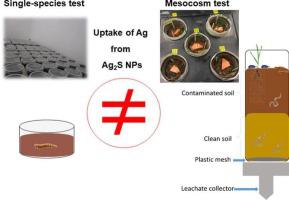NanoImpact ( IF 4.9 ) Pub Date : 2023-02-11 , DOI: 10.1016/j.impact.2023.100454 Zahra Khodaparast 1 , Cornelis A M van Gestel 2 , Ana Rita R Silva 1 , Geert Cornelis 3 , Elma Lahive 4 , Amaia Green Etxabe 4 , Claus Svendsen 4 , Marta Baccaro 5 , Nico van den Brink 5 , Neja Medvešček 6 , Sara Novak 6 , Anita Jemec Kokalj 6 , Damjana Drobne 6 , Kerstin Jurkschat 7 , Susana Loureiro 1

|
Determining the potential for accumulation of Ag from Ag2S NPs as an environmentally relevant form of AgNPs in different terrestrial organisms is an essential component of a realistic risk assessment of AgNP emissions to soils. The objectives of this study were first to determine the uptake kinetics of Ag in mealworms (Tenebrio molitor) and woodlice (Porcellio scaber) exposed to Ag2S NPs in a mesocosm test, and second, to check if the obtained toxicokinetics could be predicted by single-species bioaccumulation tests. In the mesocosms, mealworms and woodlice were exposed together with plants and earthworms in soil columns spiked with 10 μg Ag g−1 dry soil as Ag2S NPs or AgNO3. The total Ag concentrations in the biota were measured after 7, 14, and 28 days of exposure. A one-compartment model was used to calculate the Ag uptake and elimination rate constants. Ag from Ag2S NPs appeared to be taken up by the mealworms with significantly different uptake rate constants in the mesocosm compared to single-species tests (K1 = 0.056 and 1.66 g dry soil g−1 dry body weight day−1, respectively), and a significant difference was found for the Ag bioaccumulation factor (BAFk = 0.79 and 0.15 g dry soil g−1 dry body weight, respectively). Woodlice did not accumulate Ag from Ag2S NPs in both tests, but uptake from AgNO3 was significantly slower in mesocosm than in single-species tests (K1 = 0.037 and 0.26 g dry soil g−1 dry body weight day−1, respectively). Our results are of high significance because they show that single-species tests may not be a good predictor for the Ag uptake in mealworms and woodlice in exposure systems having greater levels of biological complexity. Nevertheless, single-species tests could be used as a fast screening approach to assess the potential of a substance to accumulate in biota before more complex tests are conducted.
中文翻译:

黄粉虫和 Porcellio scaber 中 Ag2S NP 暴露产生的 Ag 的毒代动力学:比较单一物种测试与室内中胚层实验
确定 Ag 2 S NPs 中Ag 的积累潜力作为不同陆地生物体中 AgNPs 的环境相关形式是对土壤 AgNP 排放进行现实风险评估的重要组成部分。本研究的目的首先是确定在中胚层试验中暴露于 Ag 2 S NPs 的粉虫 ( Tenebrio molitor ) 和木虱 ( Porcellio scaber ) 中 Ag 的摄取动力学,其次,检查获得的毒代动力学是否可以通过以下方式预测单一物种生物累积试验。在中宇宙中,粉虫和木虱与植物和蚯蚓一起暴露在掺有 10 μg Ag g −1干燥土壤(如 Ag 2 S NPs 或 AgNO)的土壤柱中3 . 在暴露 7、14 和 28 天后测量生物群中的总银浓度。使用单室模型计算 Ag 吸收和消除速率常数。来自 Ag 2 S NPs的 Ag似乎被粉虫吸收,与单一物种测试相比,中胚层中的吸收速率常数显着不同(分别为K 1 = 0.056 和 1.66 g 干土 g −1干体重天−1 ),并且发现 Ag 生物蓄积因子存在显着差异(BAF k = 0.79 和 0.15 g 干土 g -1干体重,分别为)。虱子没有从 Ag 2积累 AgS NPs 在两个测试中,但从 AgNO 3的吸收在中胚层中明显慢于在单一物种测试中(分别为K 1 = 0.037 和 0.26 g 干土 g −1干体重天−1)。我们的结果具有重要意义,因为它们表明单一物种测试可能无法很好地预测具有更高生物复杂性的暴露系统中粉虫和木虱的 Ag 吸收。尽管如此,在进行更复杂的测试之前,单一物种测试可以用作一种快速筛选方法来评估物质在生物群中积累的可能性。



























 京公网安备 11010802027423号
京公网安备 11010802027423号